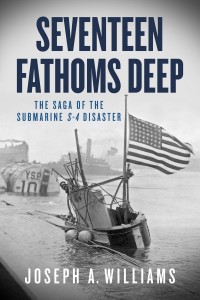
“Behind the Scenes” offers readers a closer look at our authors’ work—how they researched, what they learned, and why they decided to share the subject with the world.
In our inaugural Behind the Scenes post, author and librarian Joseph Williams sheds light on the forgotten 1927 submarine S-4 tragedy and its relevance today.
The rescue divers could hear the crew tapping out a message in Morse code: Is there any hope? After being accidentally rammed by the Coast Guard USS Paulding on December 17, 1927, the USS S-4 submarine sank to the ocean floor off Cape Cod with all 40 crew members aboard.
The tragedy had been mentioned in passing in other works, but Joseph Williams—who has always been attracted to nautical history, even before he started he started working at the Stephen B. Luce Library at the State University of New York’s Maritime College—came across a set of four musty boxes in the SUNY archives labeled “S-4 Incident.” The boxes contained a trove of information: navy hearing transcripts, correspondence, clippings, photographs, and even the glass of the periscope of the S-4. This unique collection led Williams down an S-4 research rabbit hole, and provided him with the primary sources necessary to write Seventeen Fathoms Deep: The Saga of the Submarine S-4 Disaster (September 1, 2015).
We caught up with Williams to find out what people thought about submarines in 1927 how the tragic event shaped the future of submarine safety.
Did you learn a significant amount about submarines in the process of your research?
I had to educate myself fully on early 20th-century submarines and how they operated. In order to give the book the authentic feeling of being inside the submarine, I read extensively about how old submarines worked, their cramped conditions, what the crew did for recreation, and even where the head (lavatory) was. I really wanted to impart the feeling of the time and place. What hampered things for a while was that there are no extant submarines of the same class as the S-4. Eventually, I found a great deal of help from Ric Hedman and David Johnston, webmasters of PigBoats.com. Both of these guys are submariners and are dedicated to the study of the old submarines. They gave me technical advice in the early drafts of the manuscript that proved invaluable.
What did the average American think about submarines in 1927? What was the response of the general population to the accident?
Americans in 1927 thought of submarines the way we think of rocket ships—but submarines also carried more mystique. Your average person in 1927 did not understand specifically how submarines operated. What made them even more mysterious was that there were no photographs of these vessels at the bottom of the sea, since there was no underwater photography. When the disaster occurred, much of what was happening was left to the public’s imagination. The newspapers took liberties, and did some misreporting, especially in panning the way the rescue efforts were undertaken.

Tom Eadie
One of the more thrilling aspects of Seventeen Fathoms Deep is the story of diver Thomas Eadie rescuing fellow diver Fred Michels. What was it like to be a rescue diver in the early 20th century?
Deep sea divers wore suits that weighed about 200 pounds. Divers were required to go to the bottom bearing all this weight and were connected to the surface by only two lines, a life line and an air hose. Then they were required to do work, sometimes inside a wreck like the S-4. Because of the lines and the bulkiness of the diving suit, divers could often get tangled and trapped in the wreckage. Air exhausts could clog, forcing air to blow up the diving suit, and there was decompression sickness—known to most people as the “bends.” In order to effectively combat the bends a diver had to be raised to the surface slowly, in stages, or placed into a recompression chamber on the ship.
Obviously, diving and working on the bottom of the sea are all delicate operations. Everything needs to be perfect—especially the weather, which should be warm and calm. But the collision happened on December 17, 1927. It was cold and then a storm came in, creating the worst conditions that divers had ever worked in. It is a credit to these divers who risked everything to try to save the men of the S-4.
You spent a lot of time digging through archives and valuable primary sources, but you also were able to speak with descendants of S-4 submariners and rescue crew. How did those experiences help shape Seventeen Fathoms Deep?
Most of the S-4’s crew was young, unmarried or newly married, with no children, so I wasn’t able to meet many direct descendants. However, I was fortunate enough to come across Ted Pollard, the grandson of Edward Ellsberg, one of the rescue force’s officers and a main character in Seventeen Fathoms Deep. He has collected all his grandfather’s papers, photographs, and ephemera, and featured many on the website www.edwardellsberg.com, which I came across during my research. I sent him an email, and after a lengthy correspondence, Mr. Pollard invited me to his home where he allowed me to photograph some important documents in his collection. He also digitized some of his photographs and permitted me to use them in the book.
Due to the 1927 tragedy, immediate steps were taken to improve submarine safety, allowing for an incredible submarine rescue in 1939. What were some of the innovations?
The disaster was such a national tragedy that steps were taken to improve submarine safety. The main person responsible for introducing rescue devices was a Navy officer named Charles “Swede” Momsen, who invented a rebreather (named after himself) called the Momsen Lung. The idea for this device was that a submariner could physically leave the submarine and swim to the surface by breathing in and out his own air as he floated upward. Momsen was also the primary inventor of a device called the McCann Rescue Chamber. This was a pear-shaped diving bell that fitted on the exterior hatch of the submarine. It could then be locked on and used to evacuate those inside. In 1939, the rescue chamber and the lung were both used in the rescue of the submarine Squalus, as well as other devices which were not in use at the time of the S-4 disaster.
 Aside from uncovering the “S-4 Incident” collection, what inspired you to write the book?
Aside from uncovering the “S-4 Incident” collection, what inspired you to write the book?
I felt that the S-4 was a forgotten story that needed to be told to a contemporary audience—especially to remember the heroics from incident itself. Out of the kernel of tragedy there are lessons to be learned. The S-4 is tragic in its scope, but it sets the stage for modern submarine salvage and rescue. It is certainly a great story—you see the national conversation take a horrible piece of news and turn it into positive action. The improvements and later rescues are in many ways redemption for the crew of the S-4 and the US Navy.
—compiled by Meaghan Miller
Seventeen Fathoms Deep: The Saga of the Submarine S-4 Disaster officially pubs on September 1, 2015. It is available to purchase everywhere books (and e-Books) are sold, including our website.
Joseph Williams will be talking about the S-4 tragedy at events in New England throughout the fall, including a discussion in conjunction with the Submarine S-4 Memorial Service in Provincetown, MA on November 14 at 11am.
photo credits: (Joseph Williams) courtesy of the author, (Tom Eadie) courtesy of Library of Congress, Papers of Ernest J. King
2 Comments
[…] Behind the Scenes with author Joseph A. Williams […]
[…] [Ed note: Check out our interview with Joe about Seventeen Fathoms Deep here.] […]